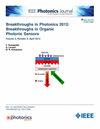高折射率光子器件的紧凑慢波电极设计
IF 2.4
4区 工程技术
Q3 ENGINEERING, ELECTRICAL & ELECTRONIC
引用次数: 0
摘要
本文提出了一种发展行慢波金属电极的方法,为集成光子器件的应用提供了广泛可调的结构。该方法特别适用于基于大群指数波导结构的光子器件中射频信号与光波的指数匹配。所提出的电极设计在设计阻抗匹配,低损耗和紧凑的射频传输线时提供了更大的灵活性,包括平面t电极与交错导电数字。这两种微结构的加入允许修改标准地-信号-地共面波导的电容和电感。这种独立的无功值设计提供了在$\sim {2}$到$\sim {6}$的广泛范围内对射频指数的工程控制,同时确保结构保持与标准射频设备集成的50 $\Omega$阻抗。虽然所提出的电极几何结构为衬底材料提供了一种不可知的设计解决方案,但这项工作的重点是在硅上的铌酸锂薄膜中的应用。本文章由计算机程序翻译,如有差异,请以英文原文为准。
Compact Slow-Wave Electrode Design for High-Index Photonic Devices
This work presents a method for the development of traveling slow-wave metallic electrodes to provide widely tunable structures for applications in integrated photonic devices. The method is particularly useful for index-matching of radio-frequency (RF) signals with optical waves in photonic devices based on waveguide structures with large group indices. The proposed electrode design provides greater flexibility when devising impedance-matched, low-loss, and compact RF transmission lines by including planar T-electrodes with interleaved conductive digits. The addition of these two microstructures permits modification of the capacitance and inductance of a standard ground-signal-ground coplanar waveguide. This independent design of the reactive values provides engineering control of the RF index in a wide range of $\sim {2}$ $\sim {6}$ $\Omega$
求助全文
通过发布文献求助,成功后即可免费获取论文全文。
去求助
来源期刊

IEEE Photonics Journal
ENGINEERING, ELECTRICAL & ELECTRONIC-OPTICS
CiteScore
4.50
自引率
8.30%
发文量
489
审稿时长
1.4 months
期刊介绍:
Breakthroughs in the generation of light and in its control and utilization have given rise to the field of Photonics, a rapidly expanding area of science and technology with major technological and economic impact. Photonics integrates quantum electronics and optics to accelerate progress in the generation of novel photon sources and in their utilization in emerging applications at the micro and nano scales spanning from the far-infrared/THz to the x-ray region of the electromagnetic spectrum. IEEE Photonics Journal is an online-only journal dedicated to the rapid disclosure of top-quality peer-reviewed research at the forefront of all areas of photonics. Contributions addressing issues ranging from fundamental understanding to emerging technologies and applications are within the scope of the Journal. The Journal includes topics in: Photon sources from far infrared to X-rays, Photonics materials and engineered photonic structures, Integrated optics and optoelectronic, Ultrafast, attosecond, high field and short wavelength photonics, Biophotonics, including DNA photonics, Nanophotonics, Magnetophotonics, Fundamentals of light propagation and interaction; nonlinear effects, Optical data storage, Fiber optics and optical communications devices, systems, and technologies, Micro Opto Electro Mechanical Systems (MOEMS), Microwave photonics, Optical Sensors.
 求助内容:
求助内容: 应助结果提醒方式:
应助结果提醒方式:


